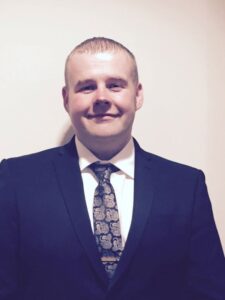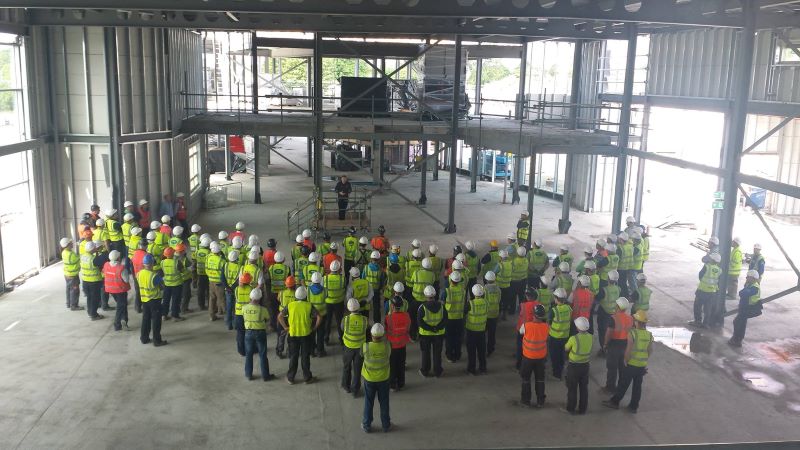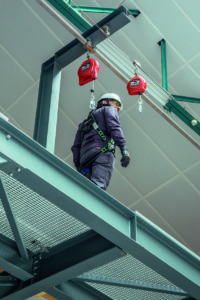SHP speaks to ex-heating engineer Dylan Skelhorn, who says workplace safety is a financial and moral imperative ahead of his presentation at Safety & Health Expo next month.

Dylan Skelhorn
However large the number, workplace accident statistics will never pack the same emotional punch as the story of a victim’s life-changing injuries following an industrial accident.
Such a story will be conveyed at Safety & Health Expo next month by former solid fuel heating engineer Dylan Skelhorn, who will recount a 33-feet fall he suffered in 2011, the severe and enduring injuries sustained and the impact on his life and family.
Dylan, who was servicing a chimney when the chimney stack collapsed underneath him, tells SHP about how sharing his story aids his recovery as well as providing a wake-up call about the potential consequences of neglecting safety.
Dylan has run his motivational safety speaking company Safety Up since 2014. He is also involved in various working-at-height safety projects and is a safety ambassador for the No Falls Foundation.
SHP: What kind of impact have your talks had? Are you aware of any attendees resolving to improve their safety practises based on your story?
Dylan Skelhorn (DS): I would say 99% of feedback has been positive.
One or two people don’t want to listen and will say things like: “I’ve been doing this for 45 years and I’ve never had an accident yet.” Famous last words – I had been working for over 14 years before my accident, so it can happen at any time.
Thankfully, the majority of people understand the consequences of an accident and my story has a positive effect on them, so hopefully this will prevent many other accidents from happening in the future.
I’ve had people approach me after my presentations and say things like: “I was going to clean my gutters at the weekend using a ladder” or “I was going to go up on the roof to fix a couple of slates, but I’m not doing it now after hearing your story, I don’t want the same thing to happen to me.”
This is great, because if I have prevented just one person from going through the same thing, then my accident hasn’t just been for one day’s wage and I’ve managed to change that person’s attitude towards safety.
SHP: What would you hope someone takes away from your talk – whether they work at height or in other dangerous situations, or they are a decision-maker with influence over safety procedures or investments?
DS: I would hope that people who hear my presentation realise the consequences of an accident and understand that an accident won’t only affect you – it will also affect your family, your friends, your colleagues and anyone connected to you.
And it affects all of these people in different ways. For example, eight of my colleagues lost their jobs due to my accident – that has affected not only them but their families also.
I would also hope that they realise that the accident could happen to them just as easily as it happened to me. I never thought an accident would happen to me and thought of myself as a safe person, but it did happen and could have easily been prevented.
I’ve heard a statistic saying that, on average, 44 people will be directly affected by an accident – in my opinion, that number is much higher.

Dylan presenting in Wales
Those eight colleagues of mine and their families total more than 44 people and that’s not including my family, friends and all of the others that I affected, so that number in reality is probably in the hundreds, maybe even thousands in some cases. So the knock-on effect of an accident is huge.
My employer was also affected financially when he was fined in court for putting my life in danger and breaking safety rules and regulations. And he’s lucky that he wasn’t sent to prison, which I see happening more often these days. He had previously caused two other employees in his company to suffer fall-from-height accidents, which he did not report to the Health & Safety Executive [HSE]. This happened before I joined the company.
 My accident and the previous two were completely avoidable but safety is a two-way street – it’s not just the employer’s responsibility but also the employee’s, who has a responsibility to act and work safely at all times.
My accident and the previous two were completely avoidable but safety is a two-way street – it’s not just the employer’s responsibility but also the employee’s, who has a responsibility to act and work safely at all times.
Safety has to be led from the top by the employer by setting a good example and leading safety. I tried to be safe in my job and asked for a safety harness when working at height and was lied to about the company having a “special dispensation” from the HSE that allowed us to work at height without safety harnesses.
This was my employer’s way of saving money by not having to purchase the safety harnesses. When told this, I knew it wasn’t true and when I spoke up about it, I was told: “If you don’t like it, you know where the door is.”
To be threatened with losing your job after a bad financial recession is worrying so I didn’t just want to walk out of it, but I didn’t want to work unsafely and risk my life. I had worked as a firefighter for six years previously and knew the risks of working at height, so I made a plan to leave the job during the summer holidays, which was only six weeks away.
I thought that during my three weeks off, I would have time to look for another job where I was allowed to work safely and I would never have to work like this again, so if I can just get through these next six weeks, being as safe as possible and without taking too many risks, I’ll be OK.
Unfortunately for me, on the day of my accident, someone didn’t turn up for work due to going out drinking the night before and I was told to go and cover for them. It wasn’t even my job so I was just in the wrong place at the wrong time and that’s how easily an accident can happen.
In hindsight, if I could go back in time to the day that my employer told me that I wasn’t allowed the correct PPE to prevent me being injured, I would have walked out of the door immediately.
Yes, I would have lost money and maybe struggled to pay bills on time, but at least I’d be safe and would have eventually secured other employment. The bills might have been paid late, but I’d have paid them eventually and paid them safely.
When I had the accident I couldn’t pay bills, and to this day, some of them have never been paid, so what was I risking my life for? I was trying to lead my safety with no backing from my employer, so it was only going to end one way – badly.
My advice to anybody who is a company owner, manager, director or anyone responsible for other people’s safety is: remember that other people’s lives and futures are in your hands, and you have a duty to make sure that they go home safely every day.
And how would you feel if you had to tell their family or loved ones that they’re not coming home today?
SHP: If talking is important therapy for overcoming trauma, then has talking about your accident for nine years to thousands of strangers aided your recovery?
DS: Talking about my accident has definitely aided my recovery. It’s a kind of therapy and the more I speak about it, the better I feel. Knowing that you may have prevented someone else from having an accident is a great feeling.
In the last nine years, I’ve spoken to over 200,000 people in thousands of companies all over the country, and if it prevents one person going through the same as me, then it’s worth doing.
It also gets me out of the house and prevents me from dwelling on my accident, as well as helping me keep moving to decrease some of the chronic pain that I have been left with.
I don’t know what I’d be doing now if I wasn’t doing these presentations, because due to my injuries, I’m no longer able to work physically, which is what I had always done previously.
I’m now classed as 40% disabled with degenerative arthritis. That is another side to having a serious accident: your physical abilities change and I’ve even lost my only hobby, which was going to the gym.
I’m a big believer in turning a negative into a positive and I think that my bad experience can be used to prevent others experiencing the same, which is definitely a positive.
SHP: How have your presentations evolved over the nine years that you’ve been doing them?
DS: I think my first presentation was only six minutes long. I now speak for around one hour, but I can do shorter presentations if required.
My presentation slot at the Safety & Health Expo is 30 minutes so it will be a shorter version of my main presentation and more of a taster of what I usually do, but long enough for people to understand the story of my accident. I think it’s important to put as much detail in as possible because certain parts of the presentation will relate to some people, but not others. So by putting in as much detail and information, hopefully at least one part will connect with everyone.
For example, when I mention going to the gym, there will be people who relate to that because they do the same. There will be others that don’t, but when I mention family or friends being affected, those that didn’t relate to the gym part will relate to the family and friends part.
There are key safety messages that relate to everyone and I feel that they are most important.
To find out more about Dylan’s presentations and his contact details visit the Safety Up website.
The Safety Conversation Podcast: Listen now!
The Safety Conversation with SHP (previously the Safety and Health Podcast) aims to bring you the latest news, insights and legislation updates in the form of interviews, discussions and panel debates from leading figures within the profession.
Find us on Apple Podcasts, Spotify and Google Podcasts, subscribe and join the conversation today!



 My accident and the previous two were completely avoidable but safety is a two-way street – it’s not just the employer’s responsibility but also the employee’s, who has a responsibility to act and work safely at all times.
My accident and the previous two were completely avoidable but safety is a two-way street – it’s not just the employer’s responsibility but also the employee’s, who has a responsibility to act and work safely at all times.
Dylan states he was in the wrong place at the wrong time. This is wrong in my opinion as he is at work and should be looked after wherever he is
I am pleased to say that having Dylan on site earlier this year for his presentation over the 4 shifts was without a doubt an eye opener for many of the staff on site, a lot of them commented afterwards on it being a positive thing for the site to do and helped raised awareness across the site, I have used Dyan’s campaign poster across the site as a reminder of the presentation and a way to remember one day it might not go to plan, so think about the routine and non routine tasks and always work safely, if… Read more »